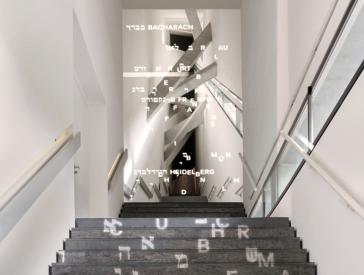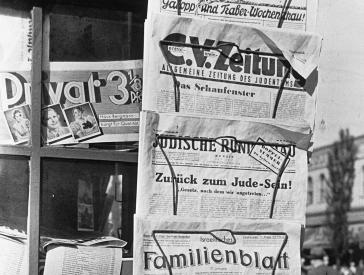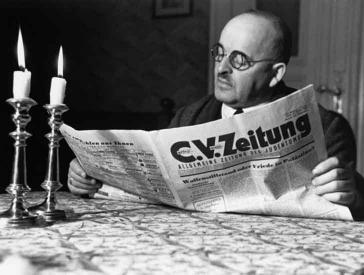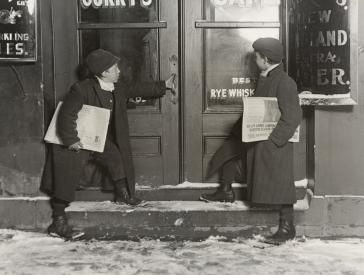R.B. Kitaj (1932-2007) Obsessions
Press Information
Press Release, Thu 20 Sep 2012
First Large Posthumous Retrospective at the Jewish Museum Berlin From 21 September 2012 – 27 January 2013
The first large posthumous exhibition of the American artist R.B. Kitaj´s oeuvre is opening at the Jewish Museum Berlin today. The last comprehensive exhibition was shown 14 years ago when the artist was still alive – in four cities between Oslo and Madrid. The upcoming exhibition of the artist, who died in 2007, includes loans from leading museums and private collections throughout the world, including works form the MoMA in New York, the Tate Gallery in London and the Thyssen-Bornemisza collection in Madrid. One hundred thirty paintings, prints and drawings from all periods of his oeuvre will be shown.
- Kontakt
-
Press office
T +49 (0)30 259 93 419
presse@jmberlin.de - Address
Jewish Museum Berlin Foundation
Lindenstraße 9–14
10969 Berlin
From the Diasporic Principle to Jewish Art
With its R.B.Kitaj retrospective the Jewish Museum Berlin is not only showing a Jewish artist, but an artist who tried to establish the concept of a Jewish art all his life. Point of departure for this search is the Diaspora as the primeval Jewish experience. Thus, the exhibition begins with the Diasporic principle and Kitaj´s early questions regarding identity and life as an outsider, a role he deliberately assumed throughout his lifetime.
His lifelong search for identification began early: he had never met his biological father and was adopted by his Jewish stepfather Walter Kitaj at the age of nine. Later he insisted on calling himself only Kitaj and to prefix his initials R.B. as first name, integrating the "Brooks" taken from his Jewish mother.
For Kitaj, a key experience for the development of a Jewish art was reading Hannah Ahrendt´s report on the Eichmann trial in the 1970s. From that moment on, an obsessive, lifelong search for his position as a Jewish artist began for Kitaj.
Three Obsessions
Kitaj himself called his treatment of the "Jewish question" his neurosis, his war, his pleasure principle – in short, his obsession. Another unrestrained passion of his was the love of books – he called himself a bibliomaniac. He bequeathed a large, comprehensive library – only a fraction of the booty he made during his forays into antiquarian book shops is shown in the exhibition. He gleaned many inspirations and motifs from these books – literal and visual quotations and picture titles can be found throughout his oeuvre. Last but not least, Kitaj´s third obsession runs like a thread through the exhibition: his wavering between the desire and veneration of women. After excessive experiences in brothels when he was a sailor in South America, he was unable to rid himself of this obsession. Along with the limits of violence and sexism it is a recurrent theme of his oeuvre.
The large retrospective at the Jewish Museum Berlin is the first to include material from the extensive private archive of the artist – R.B.Kitaj´s "Yellow Studio" in Los Angeles. The artist´s bequest at the University of California Los Angeles (UCLA) holds important clues for the decryption of the multi-layered pictures, which to this day are considered both provocative and mysterious.
For the first time, the exhibition presents Kitaj´s sources of visual and intellectual inspiration and also includes the material he used for his work: books, texts, photos, post cards, and sketches drawn on napkins or newspaper clippings, which Kitaj collected and spread out in his studio. Based on the model of Aby Warburg´s "Picture Atlas", to which Kitaj referred again and again over the course of his work, they will be shown on 20 round tables. Each table is dedicated to one specific work of Kitaj´s, tracing its evolution back to the sources that inspired him and to the elements and models he used to compose it. Thus visitors are able to gain insight into his techniques of collage and distortion.
Kitaj´s oeuvre is divided into 13 topics after which the individual rooms are named. They range from his relationship with his friends and intellectual role models to questions of Jewish identity and also include the obsessive and erotomaniacal exploration of women in his art.
Throughout his lifetime, Kitaj portrayed close friends, role models and soul mates. Two rooms alone deal with this large "Circle of Friends". This circle included the painter David Hockney, the author Philip Roth and the rabbi Albert Friedlander as well as intellectual role models such as Franz Kafka, Hannah Arendt, Sigmund Freud and also Aby Warburg.
Kitaj created complex pictures on current political, moral and cultural topics. He explored the Vietnam War, the assassination of President Kennedy and the excesses of violence and corruption in the USA and dealt with these topics in his paintings, all of which are composed with a variety of motifs. These large-format works created in surrealist style are shown in the room "Analyst of His Time".
Since the middle of the 1970s R.B. Kitaj positioned himself explicitly as a Jewish artist. Two rooms in the exhibition, "The Secret and the Public Jew" and "Obsessions", are dedicated to Kitaj´s analysis of his Jewish identity: for Kitaj "the Jewish question" was at the core of an obsessive, life-long search for his position as a Jewish artist. First and foremost he found his role-models among the writers and intellectuals of the 1920s. "Diaspora" and the "Diasporic" became key words in this search, two expressions that enabled him to harmonize his origin, situation in life and artistic impression with his Jewishness. The two rooms "Catalonia and Diaspora" and "The Library as a Diasporic Home" visualize his concept of the Diaspora as "inner exile".
As an artist, R.B. Kitaj experienced his biggest triumphs in Europe but also his deepest disappointment. Two exhibition rooms, "Tate War" and "Retreat", are dedicated to this phase of his life. When the great retrospective of his oeuvre at the Tate Gallery in 1994 triggered a flood of negative reviews, Kitaj referred to it as the "Tate War", which for him was further confirmation of his position as an outsider and ultimately caused him to return to the USA.
Responsible for the design of the exhibition are Holzer Kobler Architekturen (Zurich/Berlin). With the help of deliberately simple means, the oeuvre and life of the artist Kitaj are presented effectively. The exhibition starts with a large-scale photo-installation in the hallway, which shows Kitaj´s "Yellow Studio" in Los Angeles. In the exhibition rooms, the impression created by the pictures is the sole focus. In the cabinet at the end of the tour, the wall design takes up the color universe of the artist. In a long glass case photographs taken by Lee Friedlander are displayed which show the man and the artist Kitaj.
The exhibition R.B. Kitaj (1932–2007) Obsessions is an exhibition of the Jewish Museum Berlin in cooperation with the Kulturprojekte Berlin GmbH.
With the friendly assistance of WALL AG.
“Blogerim”, the new blog of the Jewish Museum Berlin, features a series of texts on R.B.Kitaj, written by curators and museum staff.
Symposium on R.B. Kitaj´s 80th birthday:
On the occasion of R.B. Kitaj´s (1932-2007) 80th birthday this year, the Jewish Museum Berlin will hold a symposium on 25/26 October with speakers from Germany, Great Britain and the US and in cooperation with the Akademie der Künste and Humboldt Universität Berlin. From 1993 to 2007 Kitaj was a member of the Akademie der Künste, Section Visual Arts.
The comprehensive catalog is available in German and in English. 256 pages, 200 pictures in color, comparative pictures and five fold-out panels, museum edition 34 €, press copy 12 €, Kerber Verlag Bielefeld/Berlin 2012, ISBN (Ger.): 978-3-86678-697-4, ISBN (Engl.): 978-3-86678-697-5.
The audioguide offers texts written by R.B. Kitaj on selected works.



